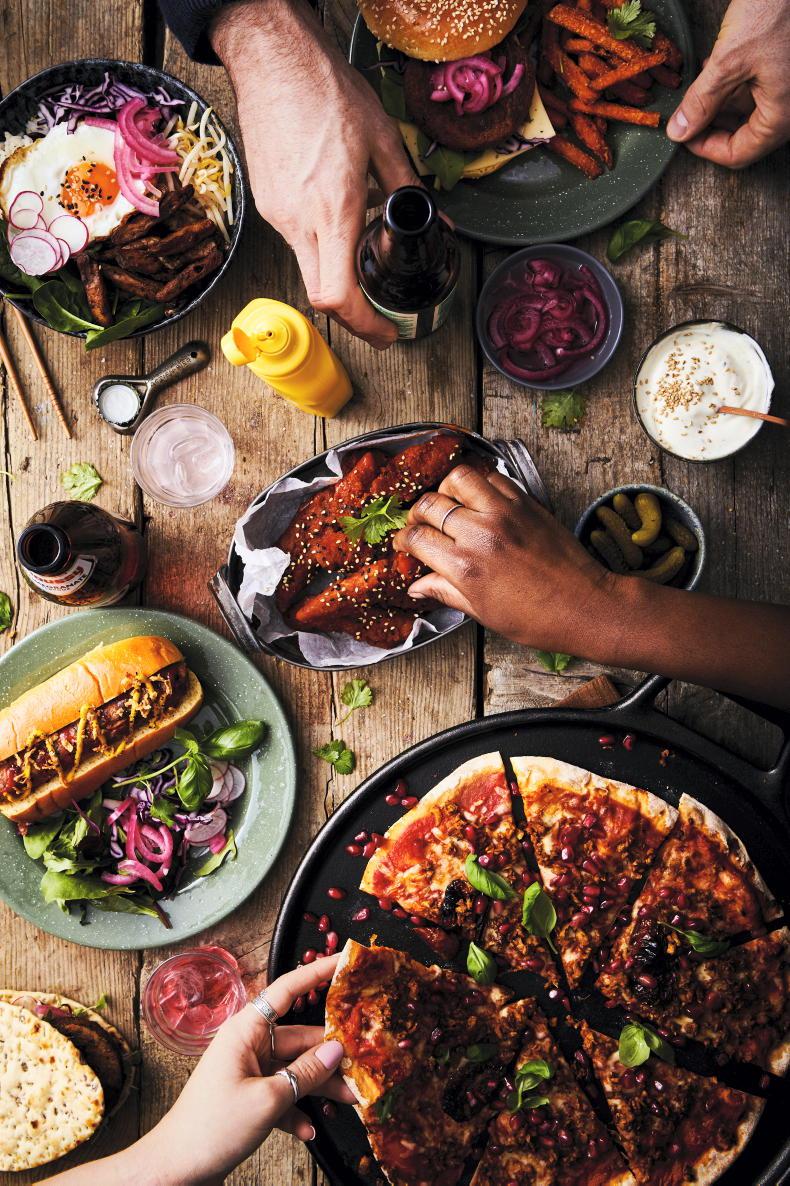The defining trait of the global food industry over the past decade has been the incredible pace of change, driven by consumer demand. Today’s consumer wants food that is nutritious and sustainably produced, which doesn’t spare on taste, texture or quality, and above all is affordable.
Consumers want locally produced food but, increasingly, they are also demanding an international twist or flavour to what they eat.
The typical Irish consumer might have Mexican on a Monday, an Italian dish midweek, some Asian cuisine by Friday and cook a traditional roast dinner by Sunday.
Unravelling this conundrum is no easy task for the modern food company, especially when the consumer is often contradictory in their dietary choices.
We know the average consumer has never been more health-conscious and worried about what they eat, yet indulgence products such as chocolate, confectionery, snacks and alcohol are still thriving sectors of the food industry.
Modern dietary choices in developed countries like Ireland are complex.
International travel has broadened the average consumer’s interest in international cuisine, while our desire for local produce is stronger than ever.
Added to this is a growing awareness among consumers about sustainable food choices, which has seen the plant-based phenomenon explode over recent years.
Modern dietary choices in developed countries like Ireland are complex
It may still command a small section of our food aisles, but plant-based food is a mega-trend that is going to grow and grow.
All of the above are now well-established trends in the food industry. But what impact has the COVID-19 had on consumer food choices? According to Fiona Sweeney, strategic marketing director at Kerry Group, the events of the last year have only accelerated these trends, if anything.
Trends
“Consumer food trends such as plant-based, immunity and health, sustainability, food safety and trust, as well as digitisation have all been present in the food industry for many years. But it’s these trends we’ve seen accelerated because of COVID-19,” says Sweeney.
“If you take plant-based as an example, it was already growing across lots of different categories including meat alternatives and dairy alternatives.
But we think that the pandemic is accelerating the trend because consumers now have this heightened interest in health, in environmental concerns and in food safety,” she adds.
Research
In a bid to better understand how consumers were changing their habits during COVID-19, Kerry Group carried out its own research in Europe during the past year, which showed that over 40% of consumers were choosing meat alternatives more often than they did 12 months ago.
The research also showed that 90% of European consumers who bought meat alternatives were eating these products more than once a week.
While the plant-based phenomenon is a difficult concept for traditional livestock farmers, Sweeney believes the consumer shift to these products is as much of a lifestyle choice as it is to do with sustainability.

Plant-based foods saw strong growth last year as health-conscious consumers sought to reduce meat intake.
Also, while it’s still a relatively new phenomenon, the plant-based category is a broad church. Sweeney says there are two types of consumers interested in plant-based right now.
The first set of consumers are those looking for alternatives to traditional meat and dairy products.
This group want alternative products to traditional meat and dairy but which still offer the exact same experience in terms of flavour, nutrition and texture.
The second group of consumers behind the plant-based lifestyle are almost veggie champions, says Sweeney, who are more interested in new vegetarian dishes made with lentils and vegetables as opposed to seeking plant alternatives to meat or dairy.
Hearty
There’s a lot of noise around plant-based foods over recent years but some other really interesting trends have emerged over the past year. The rise of discount supermarkets and own-label food products meant the days of the all-conquering consumer food brand looked to be numbered.
However, Sweeney says a lot of staple food brands roared back into life during COVID-19.
“People were cooking to escape during COVID-19. It was just something to do for many consumers. And it drove what we’re calling a ‘Back to Familiar’ trend among consumers. The surge in scratch-cooking and baking has led to this resurgence in the centre of the supermarket,” says Sweeney.
“The need for comfort has got consumers reaching out for familiar and known food brands. They are the kind of brands they may have remembered from their childhood. And that’s seen some really familiar centre store food brands experiencing fantastic growth during COVID-19,” she adds.
While it’s been an unprecedented year, this unusual trend offers food brands an opportunity to reclaim customers they may have lost over recent years or to engage for the very first time with new customers they may never have had.
Different approaches
Post-COVID-19, it will be really interesting to watch the various strategic approaches taken by different food brands as they try to retain these new found and return customers.
We may have thought the best days of many food brands were behind them but COVID-19 has turned that assumption on its head – at least for now.
Aside from the boost for familiar food brands, consumer nostalgia and comfort eating led to a resurgence in traditional food dishes like the Sunday roast, which is a form of cooking that has been in steady decline over recent decades due to time poor consumers.
But COVID-19 has left most of us with more time than we know what to do with so many consumers found themselves preparing really high-quality, showpiece cuts of meat as a way to kill some hours in the day.
Just like the food brands, Irish beef and sheep farmers need to ask themselves what they can do to keep these consumers engaged with their produce.
The decline in popularity of roast cuts of meat and the increase in demand for minced meat and burgers has certainly not helped farm gate prices over the last decade.
If Irish farmers, through Bord Bia, can develop a strategy to hang on to these consumers then it would certainly improve the outlook for the coming decade.
The explosion of e-commerce within the food supply chain due to COVID-19 has probably been the standout trend of the past 12 months. It takes the form of online ordering, click and collect, or food delivery.
The restrictions introduced across the world to stop the spread of the COVID-19 virus shuttered almost every restaurant and left many with no route to market.
Faced with no alternative, many businesses turned to online ordering in a bid to maintain some form of revenue.
What we have today is a food service sector that is utterly transformed from where it was 12 months ago, with many businesses and restaurants establishing a working online sales platform for the very first time.
Whether the model is take-away, click-and-collect or delivery, the food service landscape that emerges post-COVID-19 is going to be very different from where it was at the start of 2020, says Sweeney.

Kerry Group's strategic marketing director Fiona Sweeney.
The growth in digitisation across food businesses and restaurants presents new challenges for food producers. For instance, maintaining the crispiness or heat of food when it comes to delivery is a challenge the average restaurant will never have had to deal with before.
The solutions to these problems are there but it can often require a menu change away from ingredients that don’t travel well.
Again, it will be interesting to watch how many food service operators continue to maintain a presence in online sales, click-and-collect or delivery, once things start to return to normality.
Given that most have now invested in the required digital infrastructure, you suspect that most restaurants and food businesses will continue to maintain an active e-commerce platform. Indeed, it’s more likely that this is the new standard consumers will demand from the food sector from now on.
Overall, the global food industry has not been immune from the impact of COVID-19.
The pandemic has added cost to food businesses, played havoc with supply chains and has caused incredible disruption to the food service sector.
However, the food sector has shown its usual resilience when dealing with a crisis.
Despite the unprecedented challenges, businesses throughout the food supply chain have adapted and many have even thrived.
The pandemic has clearly accelerated many consumer trends but it has also turned other trends on their heads
Supermarket shelves have remained well stocked throughout the past year and many food businesses now have an e-commerce sales channel they never imagined a year ago.
The pandemic has clearly accelerated many consumer trends but it has also turned other trends on their heads. It’s been a very difficult year for many but there are positives for the food industry if they look for them.
And there will be opportunities as we emerge post-COVID.
Having a strong strategic understanding of the new consumer post-COVID-19 will be vital for any food business to capitalise on these opportunities.
Consumers want local produce but with international flavours.Food brands roared back to life during COVID-19.Explosion of e-commerce is the standout feature of the past year.
The defining trait of the global food industry over the past decade has been the incredible pace of change, driven by consumer demand. Today’s consumer wants food that is nutritious and sustainably produced, which doesn’t spare on taste, texture or quality, and above all is affordable.
Consumers want locally produced food but, increasingly, they are also demanding an international twist or flavour to what they eat.
The typical Irish consumer might have Mexican on a Monday, an Italian dish midweek, some Asian cuisine by Friday and cook a traditional roast dinner by Sunday.
Unravelling this conundrum is no easy task for the modern food company, especially when the consumer is often contradictory in their dietary choices.
We know the average consumer has never been more health-conscious and worried about what they eat, yet indulgence products such as chocolate, confectionery, snacks and alcohol are still thriving sectors of the food industry.
Modern dietary choices in developed countries like Ireland are complex.
International travel has broadened the average consumer’s interest in international cuisine, while our desire for local produce is stronger than ever.
Added to this is a growing awareness among consumers about sustainable food choices, which has seen the plant-based phenomenon explode over recent years.
Modern dietary choices in developed countries like Ireland are complex
It may still command a small section of our food aisles, but plant-based food is a mega-trend that is going to grow and grow.
All of the above are now well-established trends in the food industry. But what impact has the COVID-19 had on consumer food choices? According to Fiona Sweeney, strategic marketing director at Kerry Group, the events of the last year have only accelerated these trends, if anything.
Trends
“Consumer food trends such as plant-based, immunity and health, sustainability, food safety and trust, as well as digitisation have all been present in the food industry for many years. But it’s these trends we’ve seen accelerated because of COVID-19,” says Sweeney.
“If you take plant-based as an example, it was already growing across lots of different categories including meat alternatives and dairy alternatives.
But we think that the pandemic is accelerating the trend because consumers now have this heightened interest in health, in environmental concerns and in food safety,” she adds.
Research
In a bid to better understand how consumers were changing their habits during COVID-19, Kerry Group carried out its own research in Europe during the past year, which showed that over 40% of consumers were choosing meat alternatives more often than they did 12 months ago.
The research also showed that 90% of European consumers who bought meat alternatives were eating these products more than once a week.
While the plant-based phenomenon is a difficult concept for traditional livestock farmers, Sweeney believes the consumer shift to these products is as much of a lifestyle choice as it is to do with sustainability.

Plant-based foods saw strong growth last year as health-conscious consumers sought to reduce meat intake.
Also, while it’s still a relatively new phenomenon, the plant-based category is a broad church. Sweeney says there are two types of consumers interested in plant-based right now.
The first set of consumers are those looking for alternatives to traditional meat and dairy products.
This group want alternative products to traditional meat and dairy but which still offer the exact same experience in terms of flavour, nutrition and texture.
The second group of consumers behind the plant-based lifestyle are almost veggie champions, says Sweeney, who are more interested in new vegetarian dishes made with lentils and vegetables as opposed to seeking plant alternatives to meat or dairy.
Hearty
There’s a lot of noise around plant-based foods over recent years but some other really interesting trends have emerged over the past year. The rise of discount supermarkets and own-label food products meant the days of the all-conquering consumer food brand looked to be numbered.
However, Sweeney says a lot of staple food brands roared back into life during COVID-19.
“People were cooking to escape during COVID-19. It was just something to do for many consumers. And it drove what we’re calling a ‘Back to Familiar’ trend among consumers. The surge in scratch-cooking and baking has led to this resurgence in the centre of the supermarket,” says Sweeney.
“The need for comfort has got consumers reaching out for familiar and known food brands. They are the kind of brands they may have remembered from their childhood. And that’s seen some really familiar centre store food brands experiencing fantastic growth during COVID-19,” she adds.
While it’s been an unprecedented year, this unusual trend offers food brands an opportunity to reclaim customers they may have lost over recent years or to engage for the very first time with new customers they may never have had.
Different approaches
Post-COVID-19, it will be really interesting to watch the various strategic approaches taken by different food brands as they try to retain these new found and return customers.
We may have thought the best days of many food brands were behind them but COVID-19 has turned that assumption on its head – at least for now.
Aside from the boost for familiar food brands, consumer nostalgia and comfort eating led to a resurgence in traditional food dishes like the Sunday roast, which is a form of cooking that has been in steady decline over recent decades due to time poor consumers.
But COVID-19 has left most of us with more time than we know what to do with so many consumers found themselves preparing really high-quality, showpiece cuts of meat as a way to kill some hours in the day.
Just like the food brands, Irish beef and sheep farmers need to ask themselves what they can do to keep these consumers engaged with their produce.
The decline in popularity of roast cuts of meat and the increase in demand for minced meat and burgers has certainly not helped farm gate prices over the last decade.
If Irish farmers, through Bord Bia, can develop a strategy to hang on to these consumers then it would certainly improve the outlook for the coming decade.
The explosion of e-commerce within the food supply chain due to COVID-19 has probably been the standout trend of the past 12 months. It takes the form of online ordering, click and collect, or food delivery.
The restrictions introduced across the world to stop the spread of the COVID-19 virus shuttered almost every restaurant and left many with no route to market.
Faced with no alternative, many businesses turned to online ordering in a bid to maintain some form of revenue.
What we have today is a food service sector that is utterly transformed from where it was 12 months ago, with many businesses and restaurants establishing a working online sales platform for the very first time.
Whether the model is take-away, click-and-collect or delivery, the food service landscape that emerges post-COVID-19 is going to be very different from where it was at the start of 2020, says Sweeney.

Kerry Group's strategic marketing director Fiona Sweeney.
The growth in digitisation across food businesses and restaurants presents new challenges for food producers. For instance, maintaining the crispiness or heat of food when it comes to delivery is a challenge the average restaurant will never have had to deal with before.
The solutions to these problems are there but it can often require a menu change away from ingredients that don’t travel well.
Again, it will be interesting to watch how many food service operators continue to maintain a presence in online sales, click-and-collect or delivery, once things start to return to normality.
Given that most have now invested in the required digital infrastructure, you suspect that most restaurants and food businesses will continue to maintain an active e-commerce platform. Indeed, it’s more likely that this is the new standard consumers will demand from the food sector from now on.
Overall, the global food industry has not been immune from the impact of COVID-19.
The pandemic has added cost to food businesses, played havoc with supply chains and has caused incredible disruption to the food service sector.
However, the food sector has shown its usual resilience when dealing with a crisis.
Despite the unprecedented challenges, businesses throughout the food supply chain have adapted and many have even thrived.
The pandemic has clearly accelerated many consumer trends but it has also turned other trends on their heads
Supermarket shelves have remained well stocked throughout the past year and many food businesses now have an e-commerce sales channel they never imagined a year ago.
The pandemic has clearly accelerated many consumer trends but it has also turned other trends on their heads. It’s been a very difficult year for many but there are positives for the food industry if they look for them.
And there will be opportunities as we emerge post-COVID.
Having a strong strategic understanding of the new consumer post-COVID-19 will be vital for any food business to capitalise on these opportunities.
Consumers want local produce but with international flavours.Food brands roared back to life during COVID-19.Explosion of e-commerce is the standout feature of the past year.












SHARING OPTIONS